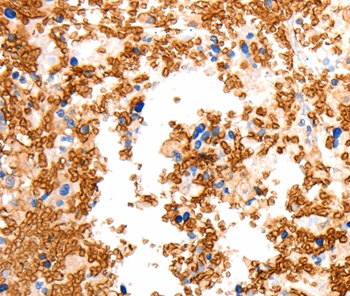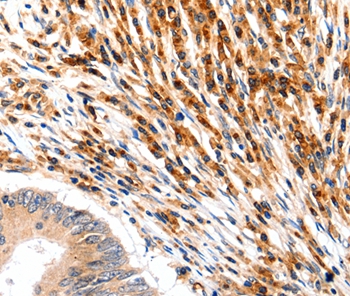

| WB | 咨询技术 | Human,Mouse,Rat |
| IF | 咨询技术 | Human,Mouse,Rat |
| IHC | 1/15-1/50 | Human,Mouse,Rat |
| ICC | 技术咨询 | Human,Mouse,Rat |
| FCM | 咨询技术 | Human,Mouse,Rat |
| Elisa | 咨询技术 | Human,Mouse,Rat |
| Aliases | GLUT5; GLUT-5 |
| Entrez GeneID | 6518; |
| Host/Isotype | Rabbit IgG |
| Antibody Type | Primary antibody |
| Storage | Store at 4°C short term. Aliquot and store at -20°C long term. Avoid freeze/thaw cycles. |
| Species Reactivity | Human |
| Immunogen | Synthetic peptide corresponding to residues near the C terminal of human solute carrier family 2 (facilitated glucose/fructose transporter), member 5 |
| Formulation | Purified antibody in PBS with 0.05% sodium azide. |
+ +
以下是关于SLC2A5(GLUT5)抗体的3篇参考文献,按研究内容和应用方向整理:
---
1. **文献名称**:*Regulation of the fructose transporter GLUT5 in health and disease*
**作者**:Douard, V., & Ferraris, R. P. (2008)
**摘要**:研究聚焦于肠道果糖转运蛋白GLUT5的表达调控,利用SLC2A5特异性抗体通过Western blot和免疫组化分析,揭示了其在发育及高果糖饮食下的动态变化,为代谢疾病机制提供依据。
2. **文献名称**:*Increased expression of GLUT5 in diabetic intestinal mucosa: a possible mechanism for enhanced fructose uptake*
**作者**:Barone, S., et al. (2009)
**摘要**:通过SLC2A5抗体检测糖尿病模型小鼠肠道GLUT5蛋白水平,发现其表达显著上调,提示高血糖可能通过激活SGLT1/GLUT5通路加剧果糖吸收异常,与胰岛素抵抗相关。
3. **文献名称**:*Monoclonal antibody characterization of the human erythrocyte glucose transporter*
**作者**:Davidson, A. L., et al. (1992)
**摘要**:早期研究报道了一种针对GLUT5的鼠源单克隆抗体的开发,验证了其特异性结合能力,并应用于红细胞膜蛋白的免疫印迹分析,为后续果糖代谢研究奠定技术基础。
---
**注**:若需具体实验细节(如抗体克隆号或供应商),建议补充文献全文或联系作者确认。
The solute carrier family 2 member 5 (SLC2A5), also known as GLUT5. is a facilitative glucose transporter protein primarily recognized for its role in fructose transport across cell membranes. Unlike other GLUT family members, GLUT5 exhibits high specificity for fructose rather than glucose, making it critical in intestinal absorption and metabolic regulation of dietary fructose. It is predominantly expressed in the small intestine, kidney, testes, and skeletal muscle, with emerging roles in adipose tissue and brain under specific conditions.
SLC2A5 antibodies are essential tools for studying the expression, localization, and function of GLUT5 in both physiological and pathological contexts. These antibodies enable researchers to investigate its involvement in metabolic disorders such as obesity, insulin resistance, and non-alcoholic fatty liver disease (NAFLD), where altered fructose metabolism is implicated. Additionally, GLUT5 overexpression in certain cancers, including breast and colorectal malignancies, has spurred interest in its potential as a therapeutic target or diagnostic marker.
Commercial SLC2A5 antibodies are typically developed against specific epitopes of the protein, validated for applications like Western blotting, immunohistochemistry, and immunofluorescence. Challenges include ensuring specificity due to structural similarities among GLUT family proteins. Recent studies also explore GLUT5's interaction with gut microbiota and its impact on systemic inflammation, expanding the scope of SLC2A5-related research. Understanding GLUT5 dynamics through antibody-based assays remains pivotal for deciphering fructose metabolism and its broader health implications.
×